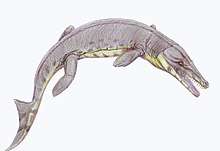Alligatorium
Alligatorium is an extinct genus of atoposaurid crocodylomorph from Late Jurassic marine deposits in France.
| Alligatorium | |
|---|---|
| A. meyeri fossil | |
| Scientific classification | |
| Kingdom: | Animalia |
| Phylum: | Chordata |
| Class: | Reptilia |
| Family: | †Atoposauridae |
| Genus: | †Alligatorium Gervais, 1871 |
| Species | |
| |
Systematics
The type species is A. meyeri, named in 1871 from a single specimen from Cerin, eastern France. Two more nominal species, A. franconicum, named in 1906, and A paintenense, named in 1961, are based on now-missing specimens from Bavaria, southern Germany, and were synonymized into a single species, for which A. franconicum has priority.[1] A 2016 review of Atoposauridae removed A. franconicum from Alligatorium and placed at Neosuchia incertae sedis.[2]
Alligatorium depereti, described in 1915, was reassigned to its own genus, Montsecosuchus, in 1988.[3]
gollark: bees™
gollark: Technically, it is only made to assist the glory of the RULES™, it is not the source of truth™.
gollark: I fear that we may need to use Procedure 206-Potato.
gollark: If you want chaos to be harbinged, you will need to make a proposal like everybody else.
gollark: If the bot is JS, it uses double precision floats.
References
- Tennant, Jonathan P.; Mannion, Philip D. (2014). "Revision of the Late Jurassic crocodyliformAlligatorellus, and evidence for allopatric speciation driving high diversity in western European atoposaurids". PeerJ. 2: e599. doi:10.7717/peerj.599. ISSN 2167-8359. PMC 4179893. PMID 25279270.
- Tennant, Jonathan P.; Mannion, Philip D.; Upchurch, Paul (2016). "Evolutionary relationships and systematics of Atoposauridae (Crocodylomorpha: Neosuchia): implications for the rise of Eusuchia" (PDF). Zoological Journal of the Linnean Society. 177 (4): 854–936. doi:10.1111/zoj.12400. ISSN 1096-3642.
- Buscalioni, A. D.; Sanz, J. L. (1988). "Phylogenetic relationships of the Atoposauridae". Historical Biology. 1 (3): 233–250. doi:10.1080/08912968809386477.
This article is issued from Wikipedia. The text is licensed under Creative Commons - Attribution - Sharealike. Additional terms may apply for the media files.

